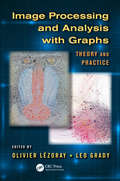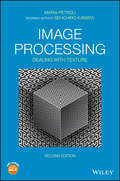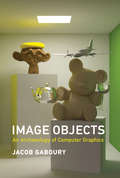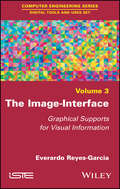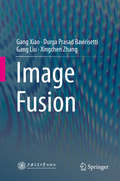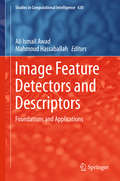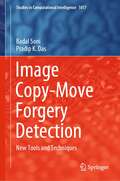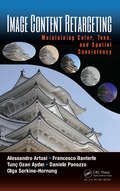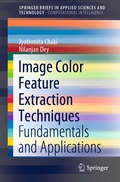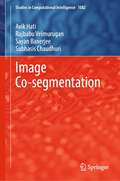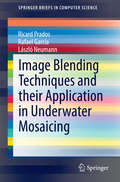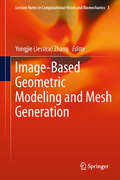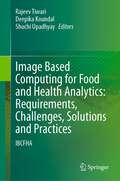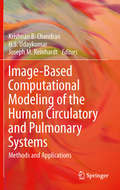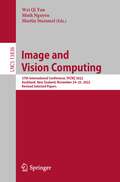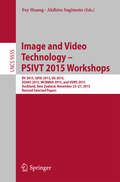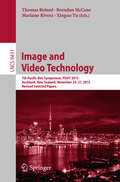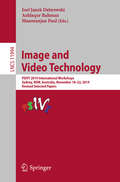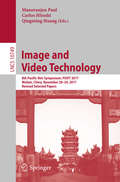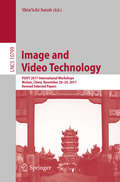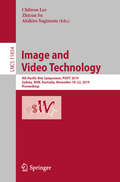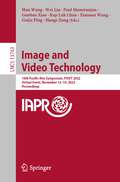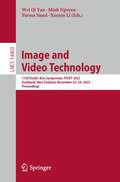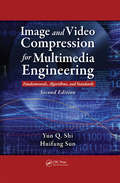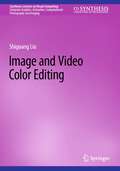- Table View
- List View
Image Processing and Analysis with Graphs: Theory and Practice (Digital Imaging and Computer Vision #5)
by OLIVER LÉZORAY AND LEO GRADYCovering the theoretical aspects of image processing and analysis through the use of graphs in the representation and analysis of objects, Image Processing and Analysis with Graphs: Theory and Practice also demonstrates how these concepts are indispensible for the design of cutting-edge solutions for real-world applications. Explores new applications in computational photography, image and video processing, computer graphics, recognition, medical and biomedical imaging With the explosive growth in image production, in everything from digital photographs to medical scans, there has been a drastic increase in the number of applications based on digital images. This book explores how graphs—which are suitable to represent any discrete data by modeling neighborhood relationships—have emerged as the perfect unified tool to represent, process, and analyze images. It also explains why graphs are ideal for defining graph-theoretical algorithms that enable the processing of functions, making it possible to draw on the rich literature of combinatorial optimization to produce highly efficient solutions. Some key subjects covered in the book include: Definition of graph-theoretical algorithms that enable denoising and image enhancement Energy minimization and modeling of pixel-labeling problems with graph cuts and Markov Random Fields Image processing with graphs: targeted segmentation, partial differential equations, mathematical morphology, and wavelets Analysis of the similarity between objects with graph matching Adaptation and use of graph-theoretical algorithms for specific imaging applications in computational photography, computer vision, and medical and biomedical imaging Use of graphs has become very influential in computer science and has led to many applications in denoising, enhancement, restoration, and object extraction. Accounting for the wide variety of problems being solved with graphs in image processing and computer vision, this book is a contributed volume of chapters written by renowned experts who address specific techniques or applications. This state-of-the-art overview provides application examples that illustrate practical application of theoretical algorithms. Useful as a support for graduate courses in image processing and computer vision, it is also perfect as a reference for practicing engineers working on development and implementation of image processing and analysis algorithms.
Image Processing: Dealing with Texture
by Maria M. Petrou Sei-ichiro KamataThe classic text that covers practical image processing methods and theory for image texture analysis, updated second edition The revised second edition of Image Processing: Dealing with Textures updates the classic work on texture analysis theory and methods without abandoning the foundational essentials of this landmark work. Like the first, the new edition offers an analysis of texture in digital images that are essential to a diverse range of applications such as: robotics, defense, medicine and the geo-sciences. Designed to easily locate information on specific problems, the text is structured around a series of helpful questions and answers. Updated to include the most recent developments in the field, many chapters have been completely revised including: Fractals and Multifractals, Image Statistics, Texture Repair, Local Phase Features, Dual Tree Complex Wavelet Transform, Ridgelets and Curvelets and Deep Texture Features. The book takes a two-level mathematical approach: light math is covered in the main level of the book, with harder math identified in separate boxes. This important text: Contains an update of the classic advanced text that reviews practical image processing methods and theory for image texture analysis Puts the focus exclusively on an in-depth exploration of texture Contains a companion website with exercises and algorithms Includes examples that are fully worked to enhance the learning experience Written for students and researchers of image processing, the second edition of Image Processing has been revised and updated to incorporate the foundational information on the topic and information on the latest advances.
Image Objects: An Archaeology of Computer Graphics
by Jacob GabouryHow computer graphics transformed the computer from a calculating machine into an interactive medium, as seen through the histories of five technical objects.Most of us think of computer graphics as a relatively recent invention, enabling the spectacular visual effects and lifelike simulations we see in current films, television shows, and digital games. In fact, computer graphics have been around as long as the modern computer itself, and played a fundamental role in the development of our contemporary culture of computing. In Image Objects, Jacob Gaboury offers a prehistory of computer graphics through an examination of five technical objects--an algorithm, an interface, an object standard, a programming paradigm, and a hardware platform--arguing that computer graphics transformed the computer from a calculating machine into an interactive medium. Gaboury explores early efforts to produce an algorithmic solution for the calculation of object visibility; considers the history of the computer screen and the random-access memory that first made interactive images possible; examines the standardization of graphical objects through the Utah teapot, the most famous graphical model in the history of the field; reviews the graphical origins of the object-oriented programming paradigm; and, finally, considers the development of the graphics processing unit as the catalyst that enabled an explosion in graphical computing at the end of the twentieth century. The development of computer graphics, Gaboury argues, signals a change not only in the way we make images but also in the way we mediate our world through the computer--and how we have come to reimagine that world as computational.
The Image-Interface: Graphical Supports for Visual Information
by Everardo Reyes-GarciaDigital practices are shaped by graphical representations that appear on the computer screen, which is the principal surface for designing, visualizing, and interacting with digital information. Before any digital image or graphical interface is rendered on the screen there is a series of layers that affect its visual properties. To discover such processes it is necessary to investigate software applications, graphical user interfaces, programming languages and code, algorithms, data structures, and data types in their relationship with graphical outcomes and design possibilities. This book studies interfaces as images and images as interfaces. It offers a comprehensible framework to study graphical representations of visual information. It explores the relationship between visual information and its graphical supports, taking into account contributions from fields of visual computing. Graphical supports are considered as material but also as formal aspects underlying the representation of digital images on the digital screen.
Image Fusion
by Gang Xiao Durga Prasad Bavirisetti Gang Liu Xingchen ZhangThis book systematically discusses the basic concepts, theories, research and latest trends in image fusion. It focuses on three image fusion categories – pixel, feature and decision – presenting various applications, such as medical imaging, remote sensing, night vision, robotics and autonomous vehicles. Further, it introduces readers to a new category: edge-preserving-based image fusion, and provides an overview of image fusion based on machine learning and deep learning. As such, it is a valuable resource for graduate students and scientists in the field of digital image processing and information fusion.
Image Feature Detectors and Descriptors
by Ali Ismail Awad Mahmoud HassaballahThis bookprovides readers with a selection of high-quality chapters that cover boththeoretical concepts and practical applications of image feature detectors anddescriptors. It serves as reference for researchers and practitioners byfeaturing survey chapters and research contributions on image feature detectorsand descriptors. Additionally, it emphasizes several keywords in boththeoretical and practical aspects of image feature extraction. The keywordsinclude acceleration of feature detection and extraction, hardwareimplantations, image segmentation, evolutionary algorithm, ordinal measures, aswell as visual speech recognition.
Image Copy-Move Forgery Detection: New Tools and Techniques (Studies in Computational Intelligence #1017)
by Badal Soni Pradip K. DasThis book presents a detailed study of key points and block-based copy-move forgery detection techniques with a critical discussion about their pros and cons. It also highlights the directions for further development in image forgery detection. The book includes various publicly available standard image copy-move forgery datasets that are experimentally analyzed and presented with complete descriptions. Five different image copy-move forgery detection techniques are implemented to overcome the limitations of existing copy-move forgery detection techniques. The key focus of work is to reduce the computational time without adversely affecting the efficiency of these techniques. In addition, these techniques are also robust to geometric transformation attacks like rotation, scaling, or both.
Image Content Retargeting: Maintaining Color, Tone, and Spatial Consistency
by Alessandro Artusi Francesco Banterle Tunç Ozan Aydın Daniele Panozzo Olga Sorkine-HornungIn recent years visual devices have proliferated, from the massive high-resolution, high-contrast screens to the tiny ones on mobile phones, with their limited dynamic range and color gamut. The wide variety of screens on which content may be viewed creates a challenge for developers. Adapting visual content for optimized viewing on all devices is called retargeting. This is the first book to provide a holistic view of the subject, thoroughly reviewing and analyzing the many techniques that have been developed for retargeting along dimensions such as color gamut, dynamic range, and spatial resolution.
Image Color Feature Extraction Techniques: Fundamentals and Applications (SpringerBriefs in Applied Sciences and Technology)
by Jyotismita Chaki Nilanjan DeyThis book introduces a range of image color feature extraction techniques. Readers are encouraged to try implementing the techniques discussed here on their own, all of which are presented in a very simple and step-by-step manner. In addition, the book can be used as an introduction to image color feature techniques for those who are new to the research field and software. The techniques are very easy to understand as most of them are described with pictorial examples. Not only the techniques themselves, but also their applications are covered. Accordingly, the book offers a valuable guide to these tools, which are a vital component of content-based image retrieval (CBIR).
Image Co-segmentation (Studies in Computational Intelligence #1082)
by Avik Hati Rajbabu Velmurugan Sayan Banerjee Subhasis ChaudhuriThis book presents and analyzes methods to perform image co-segmentation. In this book, the authors describe efficient solutions to this problem ensuring robustness and accuracy, and provide theoretical analysis for the same. Six different methods for image co-segmentation are presented. These methods use concepts from statistical mode detection, subgraph matching, latent class graph, region growing, graph CNN, conditional encoder–decoder network, meta-learning, conditional variational encoder–decoder, and attention mechanisms. The authors have included several block diagrams and illustrative examples for the ease of readers. This book is a highly useful resource to researchers and academicians not only in the specific area of image co-segmentation but also in related areas of image processing, graph neural networks, statistical learning, and few-shot learning.
Image Blending Techniques and their Application in Underwater Mosaicing
by Ricard Prados Rafael Garcia László NeumannThis work proposes strategies and solutions to tackle the problem of building photo-mosaics of very large underwater optical surveys, presenting contributions to the image preprocessing, enhancing and blending steps, and resulting in an improved visual quality of the final photo-mosaic. The text opens with a comprehensive review of mosaicing and blending techniques, before proposing an approach for large scale underwater image mosaicing and blending. In the image preprocessing step, a depth dependent illumination compensation function is used to solve the non-uniform illumination appearance due to light attenuation. For image enhancement, the image contrast variability due to different acquisition altitudes is compensated using an adaptive contrast enhancement based on an image quality reference selected through a total variation criterion. In the blending step, a graph-cut strategy operating in the image gradient domain over the overlapping regions is suggested. Next, an out-of-core blending strategy for very large scale photo-mosaics is presented and tested on real data. Finally, the performance of the approach is evaluated and compared with other approaches.
Image-Based Geometric Modeling and Mesh Generation
by Yongjie Jessica ZhangAs a new interdisciplinary research area, "image-based geometric modeling and mesh generation" integrates image processing, geometric modeling and mesh generation with finite element method (FEM) to solve problems in computational biomedicine, materials sciences and engineering. It is well known that FEM is currently well-developed and efficient, but mesh generation for complex geometries (e.g., the human body) still takes about 80% of the total analysis time and is the major obstacle to reduce the total computation time. It is mainly because none of the traditional approaches is sufficient to effectively construct finite element meshes for arbitrarily complicated domains, and generally a great deal of manual interaction is involved in mesh generation. This contributed volume, the first for such an interdisciplinary topic, collects the latest research by experts in this area. These papers cover a broad range of topics, including medical imaging, image alignment and segmentation, image-to-mesh conversion, quality improvement, mesh warping, heterogeneous materials, biomodelcular modeling and simulation, as well as medical and engineering applications. This contributed volume, the first for such an interdisciplinary topic, collects the latest research by experts in this area. These papers cover a broad range of topics, including medical imaging, image alignment and segmentation, image-to-mesh conversion, quality improvement, mesh warping, heterogeneous materials, biomodelcular modeling and simulation, as well as medical and engineering applications. This contributed volume, the first for such an interdisciplinary topic, collects the latest research by experts in this area. These papers cover a broad range of topics, including medical imaging, image alignment and segmentation, image-to-mesh conversion, quality improvement, mesh warping, heterogeneous materials, biomodelcular modeling and simulation, as well as medical and engineering applications. This contributed volume, the first for such an interdisciplinary topic, collects the latest research by experts in this area. These papers cover a broad range of topics, including medical imaging, image alignment and segmentation, image-to-mesh conversion, quality improvement, mesh warping, heterogeneous materials, biomodelcular modeling and simulation, as well as medical and engineering applications.
Image Based Computing for Food and Health Analytics: IBCFHA
by Rajeev Tiwari Deepika Koundal Shuchi UpadhyayIncrease in consumer awareness of nutritional habits has placed automatic food analysis in the spotlight in recent years. However, food-logging is cumbersome and requires sufficient knowledge of the food item consumed. Additionally, keeping track of every meal can become a tedious task. Accurately documenting dietary caloric intake is crucial to manage weight loss, but also presents challenges because most of the current methods for dietary assessment must rely on memory to recall foods eaten. Food understanding from digital media has become a challenge with important applications in many different domains. Substantial research has demonstrated that digital imaging accurately estimates dietary intake in many environments and it has many advantages over other methods. However, how to derive the food information effectively and efficiently remains a challenging and open research problem. The provided recommendations could be based on calorie counting, healthy food and specific nutritional composition. In addition, if we also consider a system able to log the food consumed by every individual along time, it could provide health-related recommendations in the long-term. Computer Vision specialists have developed new methods for automatic food intake monitoring and food logging. Fourth Industrial Revolution [4.0 IR] technologies such as deep learning and computer vision robotics are key for sustainable food understanding. The need for AI based technologies that allow tracking of physical activities and nutrition habits are rapidly increasing and automatic analysis of food images plays an important role. Computer vision and image processing offers truly impressive advances to various applications like food analytics and healthcare analytics and can aid patients in keeping track of their calorie count easily by automating the calorie counting process. It can inform the user about the number of calories, proteins, carbohydrates, and other nutrients provided by each meal. The information is provided in real-time and thus proves to be an efficient method of nutrition tracking and can be shared with the dietician over the internet, reducing healthcare costs. This is possible by a system made up of, IoT sensors, Cloud-Fog based servers and mobile applications. These systems can generate data or images which can be analyzed using machine learning algorithms. Image Based Computing for Food and Health Analytics covers the current status of food image analysis and presents computer vision and image processing based solutions to enhance and improve the accuracy of current measurements of dietary intake. Many solutions are presented to improve the accuracy of assessment by analyzing health images, data and food industry based images captured by mobile devices. Key technique innovations based on Artificial Intelligence and deep learning-based food image recognition algorithms are also discussed. This book examines the usage of 4.0 industrial revolution technologies such as computer vision and artificial intelligence in the field of healthcare and food industry, providing a comprehensive understanding of computer vision and intelligence methodologies which tackles the main challenges of food and health processing. Additionally, the text focuses on the employing sustainable 4 IR technologies through which consumers can attain the necessary diet and nutrients and can actively monitor their health. In focusing specifically on the food industry and healthcare analytics, it serves as a single source for multidisciplinary information involving AI and vision techniques in the food and health sector. Current advances such as Industry 4.0 and Fog-Cloud based solutions are covered in full, offering readers a fully rounded view of these rapidly advancing health and food analysis systems.
Image-Based Computational Modeling of the Human Circulatory and Pulmonary Systems
by Krishnan B. Chandran Joseph M. Reinhardt H. S. UdaykumarImage-Based Computational Modeling of the Human Circulatory and Pulmonary Systems provides an overview of the current modeling methods and applications enhancing interventional treatments and computer-aided surgery. A detailed description of the techniques behind image acquisition, processing and three-dimensional reconstruction are included. Techniques for the computational simulation of solid and fluid mechanics and structure interaction are also discussed, in addition to various cardiovascular and pulmonary applications. Engineers and researchers involved with image processing and computational modeling of human organ systems will find this a valuable reference.
Image and Vision Computing: 37th International Conference, IVCNZ 2022, Auckland, New Zealand, November 24–25, 2022, Revised Selected Papers (Lecture Notes in Computer Science #13836)
by Wei Qi Yan Minh Nguyen Martin StommelThis book constitutes the proceedings of the 37th International Conference, IVCNZ 2022, which took place in Auckland, New Zealand, in November 2022.The 37 papers (14 accepted for long oral presentation, 23 for short oral presentation) included in this volume were carefully reviewed and selected from 79 submissions. The conference presents papers on all aspects of computer vision, image processing, computer graphics, virtual and augmented reality, visualization, and HCI applications related to these fields.
Image and Video Technology - PSIVT 2015 Workshops
by Fay Huang Akihiro SugimotoThis book constitutes the thoroughly refereedpost-conference proceedings of six international workshops held in theframework of the 7th Pacific-Rim Symposium on Image and Video Technology, PSIVT2015, during November 23-24, 2015, in Auckland, New Zealand. The 29 revised full papers presented werecarefully selected from 58 submissions. Their topics diversely ranged fromwell-established areas to novel current trends: robot vision, RV 2015; 2D and3D geometric properties from incomplete data, GPID 2015; vision meets graphics,VG 2015; passive and active electro-optical sensors for aerial and spaceimaging, EO4AS 2015; mathematical and computational methods in biomedicalimaging and image analysis, MCBMIIA 2015; and video surveillance, VSWS 2015.
Image and Video Technology
by Thomas Bräunl Brendan Mccane Mariano Rivera Xinguo YuThisbook constitutes the thoroughly refereed post-conference proceedings of the 7thPacific Rim Symposium on Image and Video Technology, PSIVT 2015, held in Auckland,New Zealand, in November 2015. Thetotal of 61 revised papers was carefully reviewed and selected from 133submissions. The papers are organized in topical sections on color and motion,image/video coding and transmission, computational photography and arts, computervision and applications, image segmentation and classification, videosurveillance, biomedical image processing and analysis, object and patternrecognition, computer vision and pattern recognition, image/video processingand analysis, and pattern recognition.
Image and Video Technology: PSIVT 2019 International Workshops, Sydney, NSW, Australia, November 18–22, 2019, Revised Selected Papers (Lecture Notes in Computer Science #11994)
by Manoranjan Paul Joel Janek Dabrowski Ashfaqur RahmanThis book constitutes the thoroughly refereed post-conference proceedings of four international workshops held in the framework of the 9th Pacific-Rim Symposium on Image and Video Technology, PSIVT 2019, in Sydney, NSW, Australia, in November 2019: Vision-Tech: Workshop on Challenges, Technology, and Solutions in the Areas of Computer Vision; Workshop on Passive and Active Electro‐Optical Sensors for Aerial and Space Imaging; Workshop on Deep Learning and Image Processing Techniques for Medical Images; and Workshop on Deep Learning for Video and Image Analysis.The 16 revised full papers presented were carefully selected from 26 submissions. The papers cover the full range of state-of-the-art research in image and video technology with topics ranging from well-established areas to novel current trends.
Image and Video Technology
by Manoranjan Paul Carlos Hitoshi Qingming HuangThis book constitutes the thoroughly refereed post-conference proceedings of the 8th Pacific Rim Symposium on Image and Video Technology, PSIVT 2017, held in Wuhan, China, in November 2017.The total of 39 revised papers was carefully reviewed and selected from 91 submissions.The Pacific-Rim Symposium on Image and Video Technology (PSIVT) is a high-quality series of symposia that aim at providing a forum for researchers and practitioners who are being involved, or are contributing to theoretical advances or practical implementations in image and video technology.
Image and Video Technology: PSIVT 2017 International Workshops, Wuhan, China, November 20-24, 2017, Revised Selected Papers (Lecture Notes in Computer Science #10799)
by Shin'Ichi SatohThis book constitutes the thoroughly refereed post-conference proceedings of five international workshops held in the framework of the 8th Pacific-Rim Symposium on Image and Video Technology, PSIVT 2017, in Wuhan, China, in November 2017: Workshop on Human Behavior Analysis; Workshop on Educational Cloud and Image/Video Enriched Cloud Services, ECIVECS; Workshop: Vision Meets Graphics, VG; Workshop on Active Electro-Optical Sensors for Aerial and Space Imaging, EO4AS; and Workshop on Computer Vision and Modern Vehicles, CVMV.The 34 revised full papers and 2 posters presented were carefully selected from 103 submissions. The papers cover the full range of state-of-the-art research in image and video technology with topics ranging from well-established areas to novel current trends.
Image and Video Technology: 9th Pacific-Rim Symposium, PSIVT 2019, Sydney, NSW, Australia, November 18–22, 2019, Proceedings (Lecture Notes in Computer Science #11854)
by Zhixun Su Akihiro Sugimoto Chilwoo LeeThis book constitutes the conference proceedings of the 9th Pacific Rim Symposium on Image and Video Technology, PSIVT 2019, held in Sydney, NSW, Australia, in November 2019. A total of 31 papers were carefully reviewed and selected from 55 submissions. The main conference comprises 11 major subject areas that span the field of image and video technology, namely imaging and graphics hardware and visualization, image/video coding and transmission, image/video processing and analysis, image/video retrieval and scene understanding, applications of image and video technology, biomedical image processing and analysis, biometrics and image forensics, computational photography and arts, computer and robot vision, pattern recognition, and video surveillance.
Image and Video Technology: 10th Pacific-Rim Symposium, PSIVT 2022, Virtual Event, November 12–14, 2022, Proceedings (Lecture Notes in Computer Science #13763)
by Han Wang Wei Lin Paul Manoranjan Guobao Xiao Kap Luk Chan Xiaonan Wang Guiju Ping Haoge JiangThis book constitutes the conference proceedings of the 10th Pacific Rim Symposium on Image and Video Technology, PSIVT 2022, held in Bintan Island, Indonesia, in November 2022.A total of 15 papers were carefully reviewed and selected from 18 submissions. The main conference focuses on theoretical advances or practical implementations in image and video technology.
Image and Video Technology: 11th Pacific-Rim Symposium, PSIVT 2023, Auckland, New Zealand, November 22–24, 2023, Proceedings (Lecture Notes in Computer Science #14403)
by Wei Qi Yan Minh Nguyen Parma Nand Xuejun LiThis book constitutes the refereed conference proceedings of the 11th Pacific-Rim Symposium on Image and Video Technology, PSIVT 2023, held in Auckland, New Zealand, during November 22–24, 2023.The 34 full papers presented in this book were carefully reviewed and selected from 75 submissions. The main conference focuses on Image and Video Technology, a conference that gathers researchers and practitioners from around the globe to discuss the latest breakthroughs in image and video processing, analysis, and applications.
Image and Video Compression for Multimedia Engineering: Fundamentals, Algorithms, and Standards (Second Edition) (Image Processing Series)
by Yun Q. Shi Huifang Sun<p>Multimedia hardware still cannot accommodate the demand for large amounts of visual data. Without the generation of high-quality video bitstreams, limited hardware capabilities will continue to stifle the advancement of multimedia technologies. Thorough grounding in coding is needed so that applications such as MPEG-4 and JPEG 2000 may come to fruition. <p>Image and Video Compression for Multimedia Engineering provides a solid, comprehensive understanding of the fundamentals and algorithms that lead to the creation of new methods for generating high quality video bit streams. The authors present a number of relevant advances along with international standards. <p>Visual data, image, and video coding will continue to enable the creation of advanced hardware, suitable to the demands of new applications. Covering both image and video compression, this book yields a unique, self-contained reference for practitioners tobuild a basis for future study, research, and development.</p>
Image and Video Color Editing (Synthesis Lectures on Visual Computing: Computer Graphics, Animation, Computational Photography and Imaging)
by Shiguang LiuThis book covers image and video color editing research advances over the last two decades. Bringing readers up to speed on digital image and video editing techniques and research, the book delves into an area that has attracted much attention from researchers due to the rapid development of computer graphics and the widespread prevalence of digital cameras and mobile phones in daily life. Readers will get a comprehensive overview of the theory and application of color transfer, emotional color transfer, colorization, decolorization, and style transfer in altering still and moving digital images. Despite the existence of professional image editing software that can complete complex image editing work, the skills required to achieve satisfactory editing results can be prohibitive, and even professional image editors need to spend a lot of time developing and maintaining aptitude in a niche tool. Instead, the book explores image and video editing techniques that are simple and effective alternatives to such editing software that professional and amateur image editors can utilize. The book focuses on color as one of the most important features of an image or video. Image and video color editing aims to dramatically alter source images suitable for a wide range of applications.
